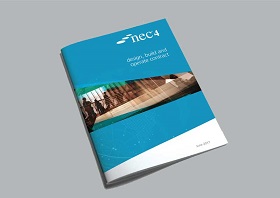NEC4 Design, Build and Operate Contract
Contents |
[edit] Introduction
NEC4 brings a new addition to the NEC family of contracts: NEC4 Design, Build and Operate Contract (DBO), released in 2017. It has been added to the suite of contracts in response to the increasing demand for contracts extending into the operational phase.
The demand is coming both from UK clients and from international funding agencies, such as the World Bank and the Asian Development Bank (ADB). In 2015, ADB commissioned NEC to draft a consultative DBO contract, the feedback from which has helped to shape the NEC4 version.
It also aligns with the UK government's commitment to 'soft landings', in which designers and constructors are involved with projects at least three years after construction completion to ensure a smoother handover to the operator.
[edit] New and existing assets
The new DBO contract is not only intended for the 'traditional' DBO approach, where the client requires a new facility or asset to be designed, constructed and then operated by a contractor. It is also available for situations where a client wants to have an existing facility or asset operated by the contractor while it is being upgraded or extended.
In such situations, the timing of the design and construction phase would normally be stated by the client, but may be determined by the contractor – which will undertake the work at a point to suit the performance requirements of the overall service.
The new DBO contract provides for option A (priced contract with price list), option C (target contract with price list) and option E (reimbursable contract).
[edit] Focus on operational needs
The contract starts with the operational and service requirements of the client and then integrates the new or replacement asset to reflect the way that the operation has been specified.
Perhaps even more than other contracts, the development of the client's requirements and specification in the scope will be crucial to the understanding, use and success of the contract.
[edit] Greater role for contractor
All the standard NEC provisions for communications, early warning and compensation events are retained along with some other features added in the NEC4 suite.
The management of the work through plans and programmes for the construction and operation phases are still important.
Recognising the greater involvement and responsibility of the DBO contractor in the operational phase, the contract has a lighter touch than some standard NEC design and build options.
[edit] Incentives and productivity
A key issue for the client is identifying and incentivising performance and productivity of the total asset. This may be through any or all of the traditional NEC approaches, including the reduction of payments for poor performance.
The new DBO contract brings incentives and productivity options together into one schedule and requires the client to identify and develop the approaches it wishes to use.
This article was originally published here on 19 June 2017 by ICE. It was written by Ross Hayes, Richard Patterson and Barry Trebes, NEC4 drafters.
--The Institution of Civil Engineers
[edit] Related articles on Designing Buildings Wiki
- Articles by ICE on Designing Buildings Wiki.
- Construction contract.
- Contract conditions.
- Design and build.
- Design build operate (DBO).
- FIDIC.
- ICE Conditions of Contract.
- NEC3.
- NEC4.
- NEC4 Alliance contract.
- NEC4 contract creates a procurement alliance arrangement for all stakeholders.
- NEC4 - legal and insurance aspects.
Featured articles and news
One of the most impressive Victorian architects. Book review.
RTPI leader to become new CIOB Chief Executive Officer
Dr Victoria Hills MRTPI, FICE to take over after Caroline Gumble’s departure.
Social and affordable housing, a long term plan for delivery
The “Delivering a Decade of Renewal for Social and Affordable Housing” strategy sets out future path.
A change to adoptive architecture
Effects of global weather warming on architectural detailing, material choice and human interaction.
The proposed publicly owned and backed subsidiary of Homes England, to facilitate new homes.
How big is the problem and what can we do to mitigate the effects?
Overheating guidance and tools for building designers
A number of cool guides to help with the heat.
The UK's Modern Industrial Strategy: A 10 year plan
Previous consultation criticism, current key elements and general support with some persisting reservations.
Building Safety Regulator reforms
New roles, new staff and a new fast track service pave the way for a single construction regulator.
Architectural Technologist CPDs and Communications
CIAT CPD… and how you can do it!
Cooling centres and cool spaces
Managing extreme heat in cities by directing the public to places for heat stress relief and water sources.
Winter gardens: A brief history and warm variations
Extending the season with glass in different forms and terms.
Restoring Great Yarmouth's Winter Gardens
Transforming one of the least sustainable constructions imaginable.
Construction Skills Mission Board launch sector drive
Newly formed government and industry collaboration set strategy for recruiting an additional 100,000 construction workers a year.
New Architects Code comes into effect in September 2025
ARB Architects Code of Conduct and Practice available with ongoing consultation regarding guidance.
Welsh Skills Body (Medr) launches ambitious plan
The new skills body brings together funding and regulation of tertiary education and research for the devolved nation.
Paul Gandy FCIOB announced as next CIOB President
Former Tilbury Douglas CEO takes helm.
























